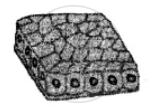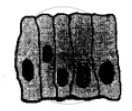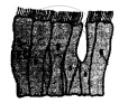Advertisements
Advertisements
Question
Prevention of substances from leaking across the tissue is provided by ______.
Options
Tight junction
Adhering junction
Gap junction
Elastic junction
Solution
Prevention of substances from leaking across the tissue is provided by Tight junction.
RELATED QUESTIONS
What is the following and where do you find them in animal body?
Ciliated epithelium
Based on the following information, identify the three types of epithelial tissue in the figures given below :
| a |  |
b |  |
c |  |
(1) Cuboidal epithelium: It consists of a single layer of cuboidal cells.
(2) Columnar epithelium: It is composed of tall, cylindrical cells with oval nuclei usually placed at the base of the cells.
(3) Ciliated epithelium: It consists of cells being hair-like cilia on their free surface.
The following statement is wrong. Rewrite it correctly by changing either one or two words.
Glandular epithelium is present in kidneys.
How many types of epithelial tissues have you studied? Write their functions.
Give structure, types and functions in brief of the following:
Epithelial tissue
Answer the following question.
Describe different types of cell junctions.
Which is not a function of epidermis?
Nerve cell does not contain
Write true (T) or false (F)
Epithelial cells have a lot of intercellular spaces.
Write true (T) or false (F)
Epithelial layer is permeable layer.
Write true (T) or false (F)
Epithelial layer does not allow regulation of materials between body and external environment.
Give reasons for
Intercellular spaces are absent in sclerenchymatous tissues.
The ______ epithelium is also known as the pavement membrane.
An epithelial layer does not allow the regulation of materials between the body and the external environment.
Write the salient features of the compound epithelium.
Explain simple epithelium and its types.
Identify the following relationship
Cuboidal: Epithelial
Cardiac: ______
Granulocytes: ______
Osteocytes: ______
Which type of tissue CORRECTLY matches with its location?
The body of sponges does not possess tissue level of organisation though it is made of thousands of cells. Comment.
Write the appropriate type of tissues in column B according to the functions mentioned in column A.
| Column A | Column B |
| a. Secretion and absorption | i. ______ |
| b. Protective covering | ii. ______ |
| c. Linking and supporting framework | iii. ______ |
